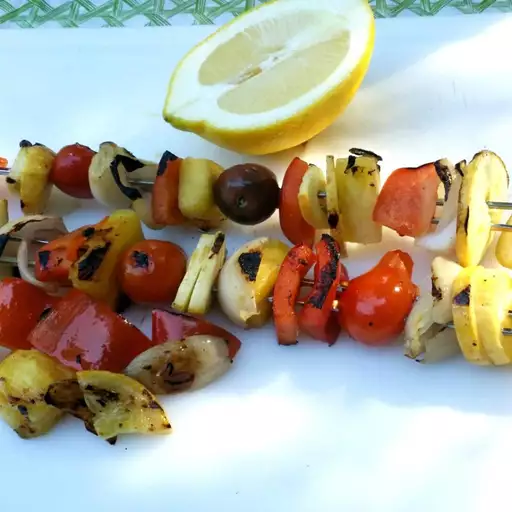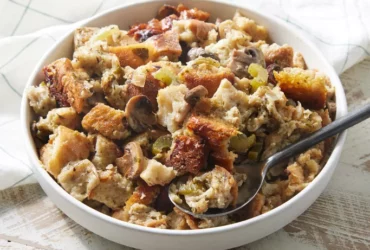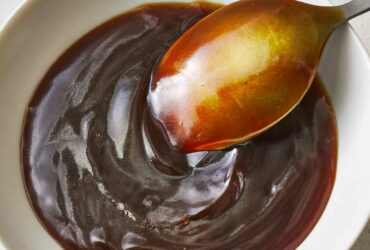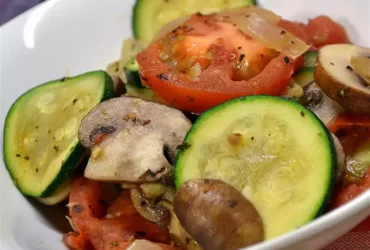Ingredients and Preparation
Select Fresh Fruits and Vegetables
The key to creating a delicious Grilled Fruit and Vegetable Kabobs recipe lies in selecting the freshest and highest quality ingredients.
Ingredients
Fruits:
- Skip the traditional melon or berries, which don’t hold up well to heat. Opt for firmer fruits instead.
- 1 cup pineapple, cut into chunks
- 1 cup peaches, sliced
- 1 cup grapes, halved
Vegetables:
- Choose colorful vegetables for added visual appeal.
- 1 cup cherry tomatoes, halved
- 1 cup mushrooms, sliced
- 1 cup bell peppers (any color), sliced
Oils and Spices:
- 2 tablespoons olive oil or avocado oil for brushing
- 2 cloves garlic, minced (optional)
- 1 tablespoon honey (optional)
- Salt and pepper to taste
- Cinnamon or other spices of your choice (optional)
- Kabob Skewers:
- 10-12 bamboo skewers, soaked in water for at least 30 minutes
To prepare the ingredients, follow these steps:
Preparation
- Cut all fruits and vegetables into similar-sized chunks or slices.
- Place fruit and vegetable chunks in separate bowls to prevent cross-contamination of flavors and textures.
- Mix a little olive oil, garlic (if using), honey (if using), salt, pepper, and any additional spices you prefer into the fruit bowl.
- Brush bamboo skewers with olive oil or avocado oil to prevent sticking.
- Thread a variety of fruits and vegetables onto each skewer, leaving space between pieces for even grilling.
- Place kabobs on the grill over medium heat. Cook for about 10-15 minutes or until fruits and vegetables show desired level of doneness.
- Serve immediately, garnished with fresh herbs or edible flowers (if desired).
Choose seasonal fruits like pineapples, peaches, kiwis, and bananas
To prepare this delicious Grilled Fruit and Vegetable Kabobs Recipe, you’ll need to gather a variety of fresh ingredients that are available during different seasons.
For this recipe, choose seasonal fruits like pineapples, peaches, kiwis, and bananas in the summer months. These sweet and juicy fruits will add natural sweetness to your kabobs.
When selecting fruits for grilling, consider their firmness and texture. Pineapples, for example, have a tough exterior that can withstand high heat, while bananas are softer and more prone to mushing under high heat.
In the spring, you can switch to strawberries, blueberries, or raspberries, which add a burst of flavor and color to your kabobs.
For vegetables, choose firm, colorful options like bell peppers, zucchini, cherry tomatoes, and onions. These will hold up well to grilling and add texture and variety to your kabobs.
Spring vegetables like asparagus and carrots are also great additions, offering a sweet and crunchy element to your dish.
Summer squash like eggplant and yellow crookneck can be used in place of zucchini for added flavor and color.
Fall brings the season’s bounty of apples and pears, which pair perfectly with autumnal spices like cinnamon and nutmeg.
Select a mix of vegetables that you enjoy and that will complement each other in terms of texture and flavor.
Some examples of great vegetable combinations include bell peppers and onions, zucchini and yellow squash, or cherry tomatoes and fresh mozzarella.
When it comes to preparing your ingredients for grilling, make sure they are clean and dry. Rinse the fruits and vegetables under cold water to remove any dirt or debris.
Pat them dry with a paper towel to remove excess moisture, which can prevent even cooking and promote flare-ups on the grill.
Cut the ingredients into bite-sized pieces, taking care not to bruise or crush the delicate flesh of the fruits and vegetables.
Avoid overcrowding your kabobs, as this can prevent them from cooking evenly. Leave about 1/4 inch of space between each piece to allow for air circulation and even grilling.
Select colorful vegetables such as bell peppers, zucchini, cherry tomatoes, and onions
To make this delicious Grilled Fruit and Vegetable Kabobs recipe, you’ll need to select a variety of colorful vegetables that will add texture and flavor to your dish.
Ingredients
- Bell Peppers: Choose bell peppers in shades of green, red, yellow, or orange. You can use one or a combination of these colors for added visual appeal.
- Zucchini: Select medium-sized zucchinis with a smooth skin and no signs of soft spots.
- Cherry Tomatoes: Pick cherry tomatoes that are firm and have a bright red color. You can also use halved or quartered grape tomatoes for added flavor.
- Onions: Choose onions with a sweet, mild flavor such as Vidalia or Maui onions. You can slice them into wedges or rings depending on your preference.
Preparation
To prepare the vegetables for grilling, follow these steps:
Cut and Prepare Vegetables
Cut the bell peppers, zucchinis, cherry tomatoes, and onions into bite-sized pieces. You can also slice them into wedges or chunks.
Thread onto Skewers
Thread the prepared vegetables onto metal skewers, leaving a small space between each piece to allow for even cooking.
Brush with Oil and Seasonings
Brush the skewered vegetables with olive oil and sprinkle with salt, pepper, and any other seasonings you like (e.g., garlic powder, dried herbs).
Once your vegetables are prepared and threaded onto skewers, you’re ready to grill them. This recipe will guide you through the grilling process and provide tips for achieving perfectly cooked fruit and vegetable kabobs.
Consider the sweetness and texture of each fruit and vegetable for a balanced kabob
To create a delicious and visually appealing grilled fruit and vegetable kabobs, it’s essential to choose a variety of ingredients that balance sweetness and texture. Here’s a guide to help you select the perfect combination:
Vegetables
- Cut bell peppers into 1-inch pieces, removing seeds and membranes for a sweet and crunchy addition.
- Slice onions into 1/2-inch rings, using only the white part for a mild flavor and firm texture.
- Quarter mushrooms, leaving stems intact for added depth and earthy sweetness.
- Cut zucchini into 1-inch slices or wedges, depending on your preference.
Fruits
- Pineapple chunks (about 1 inch in size) will add a sweet and tropical flavor to the kabob. Look for firm fruits with no soft spots.
- Halve grapes or use small clusters to provide bursts of juicy sweetness.
- Cut peaches into wedges or slices, depending on their ripeness. Use ripe but still firm peaches for the best results.
Marinades and Seasonings
- Mix olive oil, honey, Dijon mustard, salt, and pepper to create a sweet and tangy marinade. You can adjust the amount of each ingredient based on your taste preferences.
- Add garlic powder or minced fresh garlic for an extra depth of flavor.
Preparation
To prepare the kabobs, thread the vegetables and fruits onto skewers in a balanced and visually appealing pattern. Start with the bottom layer using the larger ingredients like bell peppers and mushrooms, followed by smaller items like onions and grapes.
Brush the marinade mixture evenly over the kabob, making sure to coat all the ingredients. Let it sit for at least 30 minutes to allow the flavors to meld together before grilling or broiling.
Grilling:
Preheat your grill to medium-high heat (about 400°F). Place the kabobs on the grill, turning frequently to ensure even cooking and prevent burning. Cook for about 10-15 minutes, depending on the size of the ingredients and your desired level of doneness.
Serving
Once the kabobs are cooked through, remove them from the heat and let them cool slightly. Serve immediately, garnished with fresh herbs like parsley or mint if desired. You can also serve the kabob as a side dish or add it to salads, wraps, or bowls for added flavor and texture.
Marinade and Grilling Instructions
Cooking Time and Temperature
The art of grilling is a delicate balance of heat, timing, and technique, but with the right marinade and grill settings, you can unlock a world of flavors in your grilled fruit and vegetable kabobs recipe.
To start, let’s talk about marinades. A good marinade can make all the difference between a bland, flavorless dish and one that’s bursting with excitement. When it comes to grilling, acidic ingredients like lemon juice or vinegar help break down proteins and tenderize the ingredients, while spices and herbs add depth and complexity.
For our grilled fruit and vegetable kabobs recipe, we recommend using a simple marinade of olive oil, apple cider vinegar, Dijon mustard, garlic powder, salt, and pepper. Mix these ingredients together in a bowl with some chopped fresh herbs like parsley or thyme, then brush the mixture onto each piece of fruit and vegetable as you thread them onto the skewer.
Next, let’s talk about grill settings. When it comes to grilling, temperature and timing are crucial. You want to cook your ingredients long enough to get some nice char marks on the outside, but not so long that they become dry and overcooked.
A good rule of thumb is to preheat your grill to medium-high heat (around 375-400°F or 190-200°C), then brush the grates with some oil to prevent sticking. Once the grill is hot, place the kabobs onto the grates and cook for about 5-7 minutes per side, depending on the thickness of the ingredients.
For more delicate ingredients like cherry tomatoes or bell peppers, you may only need to cook them for 3-4 minutes per side. For thicker ingredients like onions or mushrooms, you may need to cook them for 7-10 minutes per side.
Another important factor to consider is cooking time and temperature. If you’re using a gas grill, you can use a thermometer to monitor the internal temperature of your kabobs. Aim for an internal temperature of at least 145°F (63°C) for most ingredients, but be aware that some ingredients like poultry or pork may require higher temperatures.
When it comes to specific cooking times and temperatures, here are some general guidelines:
- Corn on the cob: 5-7 minutes per side at medium-high heat (375-400°F or 190-200°C)
- Mushrooms: 5-10 minutes per side at medium-low heat (300-350°F or 150-180°C)
- Onions: 5-10 minutes per side at medium-low heat (300-350°F or 150-180°C)
- Bell peppers: 3-4 minutes per side at medium-high heat (375-400°F or 190-200°C)
- Cheese: 2-3 minutes per side at low heat (250-300°F or 120-150°C)
Remember, these are just general guidelines and the specific cooking times and temperatures will vary depending on your grill, ingredients, and personal preference.
Finally, don’t forget to let your kabobs rest for a few minutes before serving. This allows the juices to redistribute and the flavors to meld together.
Preheat the grill to mediumhigh heat (around 400°F/200°C)
To achieve perfectly grilled fruit and vegetable kabobs, it’s essential to have a good marinade recipe that complements the natural flavors of the ingredients.
The marinade serves as a crucial step in preparing your kabobs for grilling. It not only adds flavor but also helps tenderize the vegetables and fruits, ensuring they retain their texture even after cooking.
For this Grilled Fruit and Vegetable Kabobs Recipe, you’ll need:
- 1/2 cup olive oil
- 1/4 cup balsamic vinegar
- 2 cloves garlic, minced
- 1 tablespoon Dijon mustard
- 1 teaspoon dried thyme
- Salt and pepper to taste
Now, let’s move on to the marinade instructions.
In a large bowl, whisk together olive oil, balsamic vinegar, garlic, Dijon mustard, and thyme until you get a smooth paste. Season with salt and pepper as needed.
Add the sliced fruits and vegetables (such as peaches, onions, bell peppers, mushrooms, cherry tomatoes, and pineapple) to the marinade. Toss gently to ensure they’re evenly coated.
Refrigerate the marinated mixture for at least 30 minutes or up to 2 hours. This will allow the flavors to penetrate the ingredients.
When you’re ready to grill, preheat your grill to medium-high heat (around 400°F/200°C). Remove the kabobs from the marinade and thread them onto skewers, leaving a small space between each piece.
Grill the kabobs for about 10-15 minutes per side or until they’re tender and slightly charred. You may need to adjust the cooking time based on the thickness of your vegetables and fruits.
Once cooked through, brush with additional balsamic glaze (optional) and serve hot. Garnish with fresh herbs or edible flowers for a beautiful presentation.
Brush the grill with olive oil to prevent sticking
To create a delicious and visually appealing grilled fruit and vegetable kabobs recipe, it’s essential to understand the importance of marinade and grilling instructions.
Marinade Instructions
Marinades are a mixture of ingredients that help to tenderize and add flavor to your food. For this recipe, you can create a marinade using a combination of olive oil, herbs, spices, and citrus juices.
Fruit Marinade
Mix together 1/2 cup of olive oil, 1/4 cup of honey, 2 cloves of minced garlic, and the juice of 1 lemon. Add in your choice of herbs such as thyme or rosemary, and a pinch of salt and pepper to taste.
Vegetable Marinade
Combine 1/2 cup of olive oil, 1/4 cup of apple cider vinegar, 2 cloves of minced garlic, and the juice of 1 lemon. Add in your choice of herbs such as basil or oregano, and a pinch of salt and pepper to taste.
Place the fruit and vegetables into separate containers or zip-top bags, and pour the marinade over them. Seal the containers or bags, and refrigerate for at least 30 minutes to allow the flavors to penetrate.
Grilling Instructions
To prevent sticking, brush the grill with olive oil before heating it up. This will create a non-stick surface that will help your kabobs cook evenly and prevent them from adhering to the grill.
- Preheat the Grill: Heat the grill to medium-high heat, about 375°F (190°C).
- Prepare the Kabobs: Thread your marinated fruit and vegetables onto skewers or kabob sticks. Leave a small space between each piece of food to allow for even cooking.
- Grill the Kabobs: Place the kabobs on the preheated grill, and cook for 8-10 minutes per side, or until the fruit and vegetables are tender and lightly charred.
Serve your grilled fruit and vegetable kabobs immediately, garnished with fresh herbs and a drizzle of olive oil if desired. Enjoy!
Grill each kabob for about 1015 minutes or until vegetables are tender
To achieve perfectly cooked kabobs, it’s essential to follow a proper marinating and grilling process. Here are some detailed instructions to help you get the best results:
Marinating the Vegetables
The marinating process is crucial in adding flavor and tenderness to your vegetables.
- Select a marinade that complements the flavors of your vegetables, such as olive oil, lemon juice, garlic, and herbs like thyme or rosemary.
- Combine the marinade ingredients in a bowl and mix well.
- Add the sliced vegetables to the marinade and ensure they are fully coated. Cover the bowl with plastic wrap and refrigerate for at least 30 minutes to an hour, or up to several hours if you prefer a stronger flavor.
Grilling the Kabobs
Preheat your grill to medium-high heat, about 400°F (200°C). Make sure the grates are clean and brush them with oil to prevent sticking.
- Thread the marinated vegetables onto skewers, leaving a small space between each piece for even cooking. You can alternate colors and textures for visual appeal.
- Season the kabobs with salt, pepper, or any additional herbs you like before grilling.
- Place the kabobs on the preheated grill and cook for about 10-15 minutes or until the vegetables are tender. You may need to rotate them halfway through the cooking time to ensure even cooking.
Cooking Times for Specific Vegetables
The cooking times will vary depending on the vegetables you’re using, so here’s a general guideline:
- Bell peppers: 8-10 minutes per side
- Zucchini and yellow squash: 5-7 minutes per side
- Mushrooms: 5-7 minutes per side
- Onions: 8-10 minutes per side
- Tomatoes: 3-5 minutes per side
Remember to check the vegetables for tenderness and adjust the cooking time as needed. You can also use a meat thermometer to ensure the internal temperature of your kabobs reaches a safe minimum of 145°F (63°C) for medium-rare.
Nutrition Benefits and Serving Suggestions
High in Antioxidants
The beauty of grilling lies not only in the smoky flavor it adds to food, but also in the numerous health benefits associated with consuming grilled fruits and vegetables. One key benefit is their high content of antioxidants.
Antioxidants are molecules that help protect cells from damage caused by free radicals, which can contribute to various chronic diseases such as cancer, heart disease, and cognitive decline. Fruits and vegetables are rich in a variety of antioxidants, including flavonoids, carotenoids, and polyphenols.
When grilling fruits and vegetables, it’s essential to choose high-antioxidant options to maximize the nutritional benefits. Some of the top antioxidant-rich ingredients for grilled fruit and vegetable kabobs include:
Pomegranate: rich in ellagic acid, a potent antioxidant with anti-inflammatory properties.
Berries (strawberries, blueberries, raspberries): high in anthocyanins, powerful antioxidants that may help reduce inflammation and improve heart health.
Pineapple: a good source of vitamin C and manganese, which can help protect cells from oxidative damage.
Mushrooms (such as portobello or cremini): contain a variety of antioxidants, including glutathione and polyphenols, that may have anti-inflammatory effects.
Bell peppers: rich in vitamin C and beta-carotene, which can help protect cells from oxidative damage and support healthy vision.
Serving suggestions for grilled fruit and vegetable kabobs include:
- As a side dish or snack on their own.
- Added to salads or yogurt parfaits for extra flavor and nutrition.
- Used as a topping for oatmeal, granola, or ice cream for added sweetness and antioxidants.
- Grilled as a centerpiece for outdoor gatherings or barbecues.
- Served as a healthy alternative to traditional dessert options, such as cake or cookies.
Grilled fruit and vegetable kabobs are rich in antioxidants from various fruits like kiwi and bell peppers
Fruit and vegetable kabobs are a delicious and healthy way to enjoy a variety of colorful produce, rich in antioxidants that help protect against cell damage and reduce the risk of chronic diseases.
The combination of fruits like kiwi and bell peppers on grilled fruit and vegetable kabobs makes for a nutritious and flavorful snack or side dish. The kiwi, in particular, is an excellent source of vitamin C and potassium, while the bell peppers are high in vitamin B6 and manganese.
The grilling process enhances the natural sweetness of the fruits and vegetables, bringing out their unique flavors and textures. When choosing ingredients for your grilled fruit and vegetable kabobs, consider using a variety of colors to ensure you get a range of nutrients.
Here are some specific nutrition benefits of common fruits and vegetables used in grilled fruit and vegetable kabobs:
Bell peppers
rich in vitamin B6 (20% DV per 100g serving) and manganese (10% DV per 100g serving), as well as antioxidants like capsaicin, which may help reduce inflammation.
Cucumbers
low in calories and rich in water, making them an excellent choice for grilled fruit and vegetable kabobs, with about 95% of their content consisting of water. They also contain small amounts of vitamin K and magnesium.
Serving suggestions for grilled fruit and vegetable kabobs include:
- Add a dollop of yogurt or a sprinkle of honey on top of the kabobs for extra flavor and nutrition.
Serve with quinoa, brown rice, or wholegrain bread for added fiber and nutrition
The grilled fruit and vegetable kabobs recipe is a delicious and nutritious meal option that provides numerous health benefits. The combination of fruits and vegetables in this recipe offers a wide range of essential vitamins, minerals, and antioxidants that support overall well-being.
Fruits used in the recipe, such as pineapple, peaches, and grapes, are rich in:
- Vitamin C: Boosts immune system and collagen production
- Antioxidants: Protect cells from damage and reduce inflammation
- Fiber: Supports healthy digestion and satiety
Vegetables used in the recipe, such as bell peppers, zucchini, and onions, are rich in:
- Vitamin A: Essential for vision, immune function, and skin health
- Fiber: Supports healthy digestion and satiety
- Antioxidants: Protect cells from damage and reduce inflammation
Servings suggestions:
Main Course
Serve the grilled fruit and vegetable kabobs as a main course with a side of quinoa, brown rice, or wholegrain bread for added fiber and nutrition. This will provide approximately 400-500 calories per serving.
Salad or Side Dish
Use the grilled fruits and vegetables as a topping for a green salad or as a side dish to complement other dishes.
Breakfast Option
Serve the grilled fruit and vegetable kabobs with scrambled eggs, wholegrain toast, and a glass of freshly squeezed orange juice for a nutritious breakfast option.
Serve the grilled fruit and vegetable kabobs with a dollop of yogurt or a sprinkle of nuts to add extra protein and crunch. You can also serve it as a snack or appetizer at your next gathering.
- Best Datanyze Alternatives for 2025 - April 24, 2025
- Best Hunter.io Alternatives for 2025 - April 22, 2025
- Best Lead411 Alternatives for 2025 - April 22, 2025














